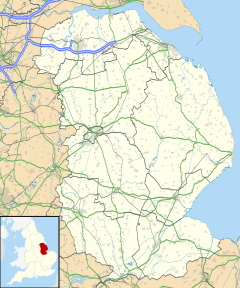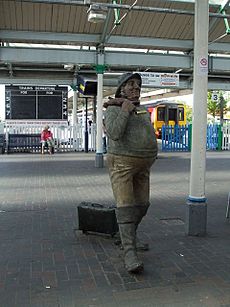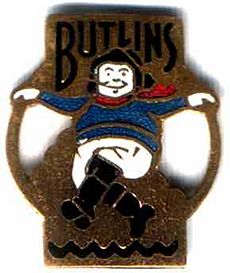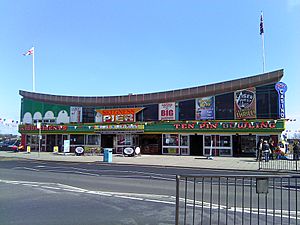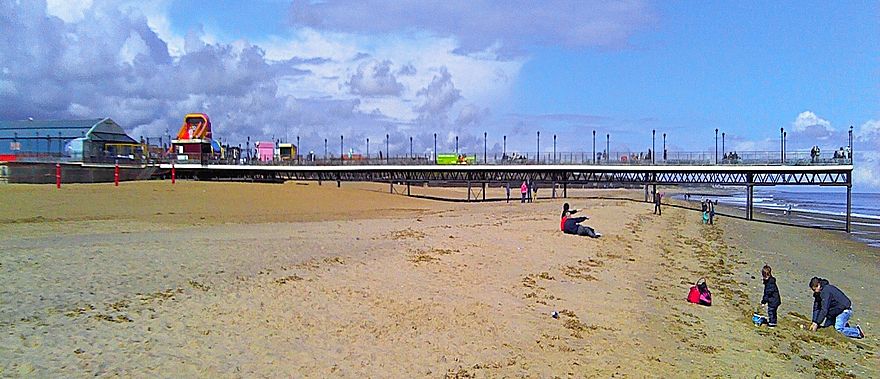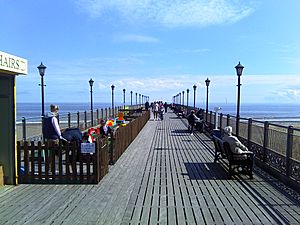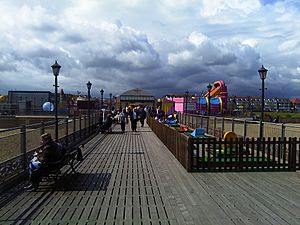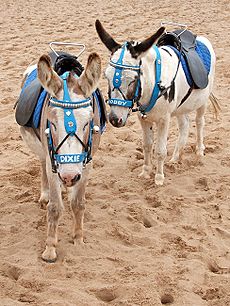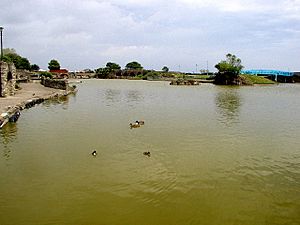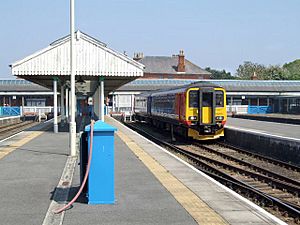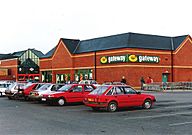Skegness facts for kids
Quick facts for kids Skegness |
|
|---|---|
| Town | |
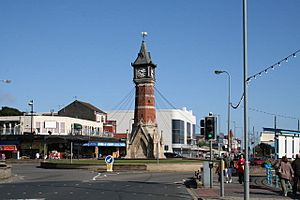 Skegness clock tower and seafront amusements |
|
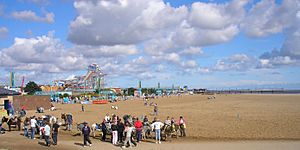 The beach with the pier in the background |
|
| Population | 19,579 (2011 Census) |
| OS grid reference | TF5663 |
| • London | 115 mi (185 km) S |
| Civil parish |
|
| District | |
| Shire county | |
| Region | |
| Country | England |
| Sovereign state | United Kingdom |
| Post town | SKEGNESS |
| Postcode district | PE24, PE25 |
| Dialling code | 01754 |
| Police | Lincolnshire |
| Fire | Lincolnshire |
| Ambulance | East Midlands |
| EU Parliament | East Midlands |
| UK Parliament |
|
Skegness ( skeg-NESS) is a seaside town and civil parish in the East Lindsey District of Lincolnshire, England. On the Lincolnshire coast of the North Sea, the town is 43 miles (69 km) east of Lincoln and 22 miles (35 km) north-east of Boston. With a population of 19,579 as of 2011, it is the largest settlement in East Lindsey. It also incorporates Winthorpe and Seacroft, and forms a larger built-up area with the resorts of Ingoldmells and Chapel St Leonards to the north. The town is on the A52 and A158 roads, connecting it with Boston and the East Midlands, and Lincoln respectively. Skegness railway station is on the Nottingham to Skegness (via Grantham) line.
The original Skegness was situated farther east at the mouth of The Wash. Its Norse name refers to a headland which sat near the settlement. By the 14th century, it was a locally important port for coastal trade. The natural sea defences which protected the harbour eroded in the later Middle Ages, and it was lost to the sea after a storm in the 1520s. Rebuilt along the new shoreline, early modern Skegness was a small fishing and farming village, but from the late 18th century members of the local gentry visited for holidays. The arrival of the railways in 1873 transformed it into a popular seaside resort. This was the intention of The 9th Earl of Scarbrough, who owned most of the land in the vicinity; he built the infrastructure of the town and laid out plots, which he leased to speculative developers. This new Skegness quickly became a popular destination for holiday-makers and day trippers from the East Midlands factory towns. By the interwar years the town was established as one of the most popular seaside resorts in Britain. The layout of the modern seafront dates to this time and holiday camps were built around the town, including the first Butlin's holiday resort which opened in Ingoldmells in 1936.
The package holiday abroad became an increasingly popular and affordable option for many British holiday-makers during the 1970s; this trend combined with declining industrial employment in the East Midlands to harm Skegness's visitor economy in the late 20th century. Nevertheless, the resort retains a loyal visitor base and has increasingly attracted people visiting for a short holiday alongside their trip abroad. Tourism increased following the recession of 2007–09 owing to the resort's affordability. In 2011, the town was England's fourth most popular holiday destination for UK residents, and in 2015 it received over 1.4 million visitors. It has a reputation as a traditional English seaside resort owing to its long, sandy beach and seafront attractions which include amusement arcades, eateries, Botton's fairground, the pier, nightclubs and bars. Other visitor attractions include Natureland Seal Sanctuary, a museum, an aquarium, a heritage railway, an annual carnival, a yearly arts festival, and Gibraltar Point nature reserve to the south of the town.
Despite the arrival of several manufacturing firms since the 1950s and Skegness's prominence as a local commercial centre, the tourism industry remains very important for the economy and employment. But the tourism service economy's low wages and seasonal nature, along with the town's aging population, have contributed towards high levels of relative deprivation among the resident population. Poor transport and communication links are barriers to economic diversification. Residents are served by five state primary schools and a preparatory school, two state secondary schools (one of which is selective), several colleges, a community hospital, several churches and two local newspapers. The town is home to a police station, a magistrates court and a lifeboat station.
Contents
Geography
Longshore drift carries particles of sediment southwards along the Lincolnshire coast; at Skegness, the sand settles out in banks which run at a slight angle to the coast. The slightly elevated dune land sheltered the small natural harbour which the Danes found behind the banks. The finer sediment drifts on to reach the mud of the Wash, beyond Gibraltar Point.
The civil parish extends westwards along the A158 to the west side of the South View Hotel, and the boundary follows North Drain, bordering Burgh le Marsh. Just north of Mill Hill it borders Addlethorpe, passing to the west of Ash Tree Farm, the airfield and Skegness Water Leisure Park. At the north end of the leisure park it borders Ingoldmells, and the boundary follows to the south of Wall's Lane. The boundary crosses the A52 at a subway across the road, just south of the Butlin's camp. To the south of the hotel on the A158, the parish follows Main Drain, to the west of Warth Lane. Just south of Ivy House, it crosses the A52 and borders Croft. The boundary follows Cow Bank Drain, over a level crossing, to the north of Croft Grange, then passes through Bramble Hills, just north of Seacroft Golf Course to the sea.
Skegness is on the drier eastern side of Britain: this is often used in promoting it as a holiday resort.
Climate
As with most of the British Isles, Skegness experiences a maritime climate with warm summers and cool winters. Temperature extremes since 1960 have ranged from 32.4 °C (90.3 °F) In August 1990, down to −10.1 °C (13.8 °F) in February 2012, which is the lowest recorded temperature in recent years.
| Climate data for Skegness Wainfleet, elevation: 3m (1981-2010) Extremes (1960 - present) | |||||||||||||
|---|---|---|---|---|---|---|---|---|---|---|---|---|---|
| Month | Jan | Feb | Mar | Apr | May | Jun | Jul | Aug | Sep | Oct | Nov | Dec | Year |
| Record high °C (°F) | 14.1 (57.4) |
17.2 (63.0) |
21.7 (71.1) |
22.7 (72.9) |
27.1 (80.8) |
30.7 (87.3) |
32.0 (89.6) |
32.4 (90.3) |
26.7 (80.1) |
27.4 (81.3) |
17.6 (63.7) |
14.5 (58.1) |
32.4 (90.3) |
| Average high °C (°F) | 6.6 (43.9) |
6.9 (44.4) |
9.7 (49.5) |
12.0 (53.6) |
15.2 (59.4) |
18.1 (64.6) |
20.5 (68.9) |
20.8 (69.4) |
17.8 (64.0) |
14.0 (57.2) |
9.7 (49.5) |
6.8 (44.2) |
13.2 (55.8) |
| Daily mean °C (°F) | 4.1 (39.4) |
4.1 (39.4) |
6.3 (43.3) |
8.1 (46.6) |
11.1 (52.0) |
14.0 (57.2) |
16.2 (61.2) |
16.4 (61.5) |
14.0 (57.2) |
10.9 (51.6) |
6.9 (44.4) |
4.3 (39.7) |
9.7 (49.5) |
| Average low °C (°F) | 1.6 (34.9) |
1.2 (34.2) |
2.8 (37.0) |
4.2 (39.6) |
6.9 (44.4) |
9.9 (49.8) |
11.9 (53.4) |
11.9 (53.4) |
10.1 (50.2) |
7.7 (45.9) |
4.1 (39.4) |
1.8 (35.2) |
6.2 (43.2) |
| Record low °C (°F) | −10.0 (14.0) |
−10.1 (13.8) |
−6.7 (19.9) |
−4.4 (24.1) |
−1.0 (30.2) |
1.9 (35.4) |
3.9 (39.0) |
3.3 (37.9) |
1.7 (35.1) |
−1.4 (29.5) |
−6.0 (21.2) |
−9.7 (14.5) |
−10.1 (13.8) |
| Average precipitation mm (inches) | 53.3 (2.10) |
36.8 (1.45) |
46.1 (1.81) |
40.7 (1.60) |
49.2 (1.94) |
53.1 (2.09) |
56.1 (2.21) |
57.6 (2.27) |
53.9 (2.12) |
63.8 (2.51) |
59.3 (2.33) |
50.5 (1.99) |
620.5 (24.43) |
| Average precipitation days (≥ 1.0 mm) | 11.2 | 10.0 | 10.4 | 9.2 | 9.0 | 10.0 | 9.1 | 9.9 | 9.0 | 10.4 | 12.4 | 11.3 | 121.6 |
| Source 1: Met Office | |||||||||||||
| Source 2: KNMI | |||||||||||||
History
Early history
The name indicates that Skegness has its origin in the Danish period of settlement of England although there is no reference to a village named Skegness in the Domesday Book. The town's name means either "Skeggi's headland" or "beard-shaped headland" (possibly referring to the banks at an angle to the coast). Skeggi(meaning "bearded one"), may have been one of the Vikings who established the original settlement to the east of the current town which was washed away by the sea in the early 16th century; or the Old East Norse word skegg "beard".
Lying within the historic county boundaries of Lincolnshire from a very early time, the parish of Skegness was in the Marsh division of the ancient Wapentake of Candleshoe in the Parts of Lindsey.
In August 1642, a consignment of arms and money, probably raised by Queen Henrietta Maria in the Netherlands to support King Charles I's campaign in the civil war, was forced into Skegness by the ships of the Parliamentarian Earl of Warwick.
Railway
Skegness was primarily a fishing village and small port, and significant numbers of visitors were not seen before the arrival of the railway in 1875. In 1908, the Great Northern Railway commissioned a poster to advertise excursions to the resort: the first such excursion was from King's Cross, London on Good Friday 1908, leaving London at 11.30 am. The "Skegness is so Bracing" poster featuring the Jolly Fisherman helped to put Skegness on the map and is now famous. The poster, derived from an oil painting by John Hassall, was purchased by the railway company for 12 guineas (£12.60). However Mr Hassall did not visit the resort until 1936. He is said to have died penniless. Skegness is now served by an East Midlands Trains service from Nottingham via Grantham.
Resort town and Butlin's
Most of the land in the modern centre of Skegness formed part of the estate of the Earl of Scarbrough. He and agent H. V. Tippet realised that the extensive sandy beach could be made attractive to holidaymakers from the industrial towns of the Midlands, a clientele already developed by Thomas Cook. He planned the town as a resort from 1877 and it expanded rapidly, but along with many other UK resorts, especially those on the cold North Sea, it lost out to the cheap package holiday boom which opened up Spain (in particular) to the average holidaymaker, especially when currency restrictions were lifted in the 1970s and travellers could leave the UK with more than 65 pounds.
Ingoldmells, the parish to the north of Skegness, was the site of the UK's first holiday camp, started by Billy Butlin in 1936. Butlins is still there today, at the north end of the town, on the road to Ingoldmells. It maintains its appeal as a destination for family holidays, and attracts thousands to the resort in the low season with music weekends encompassing '60s, '80s, soul and other genres.
The Wash incident
The Wash incident took place in the early hours of 5 October 1996 when a "strange red and green rotating light" was seen by Skegness residents and police officers to the southeast of Skegness, who then contacted the Coastguard at Great Yarmouth. It later involved many RAF stations, including RAF Neatishead, and GCHQ. The object was probably not an aircraft because although it could be seen on radar, it had no transponder. The Skegness News, a local newspaper which no longer exists, investigated the incident and sought confirmation of the object from the Jodrell Bank Observatory. In their report to the RAF, the observatory said that Venus, "the queen of UFOs", which had been shining with exceptional brilliance in the early morning sky to the east, probably explained the light shown on the video. The object was caught on video by Skegness Police. The RAF decided the stationary blip was a permanent echo of the 272 ft tall St Botolph's Church, Boston, and the object on the video was the planet Venus.
Present day
In March 2005, Skegness took the top spot in a survey by Yours magazine, looking at the best retirement places in the UK. Yours researchers visited sixty likely towns. The factors involved in judging included house prices, hospital waiting lists, the crime rate, council tax rates, activities and attractions, weather patterns and ease of transport. Skegness has also been described by Lonely Planet's Great Britain guide as "everything you could want" in a seaside resort. On 22 July 2008 the newly elected Mayor of London, Boris Johnson, caused controversy in an article in the Daily Telegraph, where he declared "Stuff Skegness, my trunks and I are off to the sun", in his desire to have a foreign holiday that year.
Tourist industry
The town is popularly known as Skeg, Skeggy, Costa del Skeg, Skegvegas, or "the Blackpool of the East Coast", and has a famous mascot, the Jolly Fisherman (designed by John Hassall in 1908 for the Great Northern Railway), and a slogan - "Skegness is so bracing" - a reference to the chilly prevailing north-easterly winds that can and frequently do blow off the North Sea. The slogan is thought to have come from an unknown member of staff of the railway. The poster was first seen at Easter in conjunction with an excursion from King's Cross railway station. The last of these trips ran in 1913.
Further up the coast are the other holiday resorts of Mablethorpe, Sutton-on-Sea, Ingoldmells and Chapel St Leonards.
Many of the hotels, guest-houses, self-catering flats and bed & breakfast establishments in and around the Skegness area are members of the Skegness East Coast and Wolds Hospitality Association, an association formed in April 2008 after the merging of two previous associations, the Skegness Hoteliers' Association, consisting of hotel, bed and breakfast and guest house accommodation providers, and the Skegness Self Catering Association, consisting of holiday flats, chalet and caravan parks.
Skegness, like many British resorts, has suffered in recent years due to the increase in cheap foreign package holidays over staying at home. In the 18 months leading up to the end of 2008, the resort had suffered the destruction by fire of three of its most popular attractions - The Dunes pub at Winthorpe, the Parade Complex which housed a nightclub, bar and amusement arcade, and a seafront building housing two bars and a fish and chip shop.
Landmarks
Diamond Jubilee Clock Tower
At the end of Lumley Road is the town's clock tower, built in 1898-99 to mark Queen Victoria's Diamond Jubilee in 1897, and funded through public subscription. With the "Jolly Fisherman" mascot, it is the most recognised symbol of Skegness. The Diamond Jubilee Clock Tower became the subject of a hoax in the Skegness Standard on 1 April 2009, when the newspaper claimed that it was about to be dismantled and moved to a museum. It is featured as a 3D rendering in Google Earth.
Gardens
Beyond the clock tower, Tower Esplanade leads to the beach, with a statue of the Jolly Fisherman in the Compass Gardens to one side and the entrance to the once-popular boating lake on the other. The name Lumley comes from the surname of the Earl of Scarbrough's family. St Matthew's Church of Early English Gothic style is on Lumley Avenue, built by the Earl of Scarbrough in 1879, and St Clement's is on Church Road North. Tower Gardens, previously known as the Pleasure Gardens, opened in 1878 after being donated by the Earl of Scarbrough. The gardens have events during the summer.
Pier
Skegness had a 614 yards (562 m) long pier which was opened on Whit Monday 1881 at a cost of £20,840 and was at the time the fourth longest in England. It was a T-shaped pier with a saloon/concert hall at the pier head. Steamboat trips ran from the pier to the Wash and Hunstanton in Norfolk from 1882 until 1910. In 1919, it was damaged by a drifting ship, the schooner Europa, and it took twenty years to raise the money to fully repair it. In the Second World War, the pier was closed and parts of the decking was removed as part of anti-invasion policies and did not reopen until 1948 following repairs. The north east corner of the pierhead suffered damage during the North Sea flood of 1953 and the pier entrance was flooded but the main structure survived. In the early 1970s the pier entrance archway was demolished despite it being classed as Grade II listed building and at the same time the pierhead theatre was enlarged from a seating capacity of 700 to 1,000.
On Wednesday 11 January 1978 a northerly severe gale and storm surge which coincided with high spring tides brought disaster and Skegness Pier along with other piers at Margate, Herne Bay and Hunstanton was irretrievably damaged and only 127 yards of landward pier deck walkway from the main entrance was left with the eastern shelters and the pierhead totally cut off and isolated from the shoreline. Debris from the wrecked pier was scattered for several miles around with souvenir hunters coming into the area to see what they could find.
For several years following the storm these two isolated structures remained as features on Skegness beach whilst plans to try to repair the pier and relink the structures were sought but this failed citing the costs as simply too high and in 1983 the eastern shelters were dismantled and demolished. By 1985 the decision was made to demolish the now derelict and isolated pierhead and theatre as the building was falling into a state of disrepair as the upper deck of the structure had been badly damaged following the 1978 storm although it had become a roosting place for hordes of starlings. It was considered a risk to small shipping and also to the public. Special permission for its demolition was granted as it was a Grade II listed building as was the rest of the pier. It was planned to dismantle the pierhead in stages starting from October 1985 and just as work was getting underway the structure caught fire and two stranded workmen had to be rescued by the town's lifeboat. After the fire burned itself out only the cast-iron stanchions were left and these were removed in January 1986 on one of the lowest tides of that year.
Today the pier is only 129 yards (118m) long and no evidence remains of the old pierhead and shelters but what remains of the landward pier deck walkway has since undergone major refurbishment and is now once again a tourist attraction, Though a tiny amount of the structure still stands from the sand, with a triangular sign warning of the piece of iron's presence. Despite its much reduced length it is a major landmark along the beach as far as Gibraltar Point to the south and Ingoldmells to the north.
Other
The RNLI has a station in Skegness manned by a crew who are volunteers except for the coxswain, and equipped with two lifeboats - the all-weather Lincolnshire Poacher and a smaller dinghy-style inshore boat. The Coastguard have a base on the town's industrial estate.
Two miles (3 km) out to sea is an offshore drilling platform for gas, and clearly visible from the town is the large Lynn and Inner Dowsing Wind Farm operated by Centrica. A larger wind farm further out to sea has been proposed.
Leisure
On the main seafront road, Grand Parade, is the Embassy Theatre, fairground rides, amusement arcades, novelty outlets, a crazy golf course, fish and chip shops and other takeaways, and bars.
Skegness holds an annual carnival in August, which includes a week-long programme of events throughout the town. East Lindsey District Council previously operated the carnival procession but handed control of the event to a group of volunteers, who now run it on a smaller scale.
During the summer, since 2009, Skegness has held a music, art and cultural event, the SO Festival, which coincides with a switch-on of seafront illuminations.
On 16 August 2007, a fire at an entertainment and shopping complex on seafront destroyed the Strike's nightclub and Lucky Strike amusement arcade. Because of the severity of the fire, what remained of the complex had to be demolished. A new "Lucky Strike" family amusement arcade has been built with three floors, including "Cafe 66" on the ground floor, "WOW" milkshake bar and "Coffee Point" above and "Waterfront" a restaurant on the top tier. It is operated by Bell's Leisure, who operate other arcades such as "Plaza" further up Grand Parade near the pier and "Planet Fun" in Ingoldmells, near Fantasy Island further up the coast. In late 2008, a further fire at a building on the seafront took place, causing significant damage to a pub and amusement complex.
Places of interest
Beach
The long and wide sandy beach features donkeys for riding, and has several times won the Blue Flag beach award for cleanliness. The Central beach has retained its blue flag status for 2011/12. From 2007 the Quality Coast Award was introduced by Keep Britain tidy, an environmental charity focusing on raising the standards of beaches in England. This award is handed out in recognition of the achievements of beach managers and guarantees holiday makers that the beach is of the highest standards. The Central beach has been given the coveted "Quality Coast Award".
The shape of the beach has changed considerably in the last decade. In the mid-1990s, an extensive programme of enhancement to the sea defences was carried out, with the installation of rock armour along the length of Lagoon Walk. This provided a barrier against the sea's tremendous power, but consequently the highest tides were forced southwards. The Environment Agency predicted that the sea would destroy Skegness Boating Club's boat compound and possibly wipe out a grassed picnic area just behind it. As the tides shifted, the boat compound was indeed flattened by the sea. Sand dunes were washed away and significant new creeks were carved into the beach, but so far the picnic area remains intact. The boating club now has a new compound just off the Princes Parade car park.
Fairy Dell
On the southern foreshore sits a popular family attraction, the Fairy Dell paddling pool. Closed by the district council because of health and safety fears in 2004, the pool became a centre of controversy as people from Skegness, elsewhere in the country and as far afield as Australia voiced their dismay at the loss of such a time-honoured free facility. Taxpayers and town councillors joined forces with the local press to campaign for the Fairy Dell to be reopened, and the district council gave way to public pressure and promised to have it back in operation by summer 2006.
On 22 May 2006, the Fairy Dell re-opened following a major refurbishment during which improvements were made to the pool such as clean-filtered water and extra water features.
Natureland Seal Sanctuary
Natureland Seal Sanctuary provides visitors with entertainment, education and conservation. The sanctuary opened its doors in 1965 and attracts thousands of visitors each year. The sanctuary features seals, penguins, tropical and seawater aquariums and koi pond, a pets corner, tropical house and floral palace. Natureland works with abandoned baby seals which are often washed up on the beach and in need of medical care. Staff treat and rear the seals until they are well enough to be returned to the sea.
Other
- To the south of the town is Gibraltar Point National Nature Reserve, on the northern limit of the Wash.
- The Village Church Farm is a museum of agricultural life covering the 17th to 20th centuries.
- The town is a centre for bowls.
- Annual world's premier Meccano exhibition is staged in the Embassy Theatre, on the Grand Parade by the seafront and opened in September 1989.
- Botton's Pleasure Beach, featuring roller coasters, mini merry-go-round (the Gallopers), dodgems and many traditional and modern rides as well as its annual end-of-season firework display.
- The Pier Field, a recreational area which doubles as a car park, which made the news prominently after an announcement in 2014 that the district council was to consider selling it for the building of a Premier Inn hotel. This issue is still ongoing, with some local residents opposed to it.
Transport
Road
The A52 road from Newcastle-under-Lyme to Mablethorpe passes through Skegness via Nottingham, Grantham and Boston. The A158 from Lincoln terminates in the town. The A1028 connects Skegness with the A16, which runs from Grimsby to Peterborough via Louth.
Bus
Omnibus services reached the village from Boston before the development of the resort; by the 1840s, Brown's omnibus made the journey from Boston three days a week. As of 2020, Stagecoach Lincolnshire is the main bus operator in the town with regular services on routes to Ingoldmells and Chapel St Leonards; there are Lincolnshire InterConnect services up the coast as far as Mablethorpe and inland to Boston and Lincoln.
Railway
Skegness railway station is the terminus for the Grantham to Skegness ("Poacher") line which runs hourly services from Nottingham via Grantham. Opened in 1873, it was the final station on the Firsby–Skegness branch of the East Lincolnshire Railway. The number of people travelling by car and coach probably overtook the number using the train in the 1930s, a trend solidified in the post-war years. The station was earmarked for closure in the Beeching cuts in the 1960s, but a third of the summer visitors still used it and lobbying by the urban district council preserved passenger services. The line was nevertheless closed to freight traffic in 1966 and the main interconnecting line, the East Lincolnshire Railway, was dismantled from Firsby to Grimsby in 1970. The passenger timetable was reduced to save costs in 1977, but a full timetable returned in 1989 and improvement works were carried out in 2001 and 2011; the latter seeing the old station master's house demolished. As of 2020, trains run the full length of the Poacher Line and the Nottingham to Grantham Line to give connections to the East Midlands; Nottingham, Grantham, Boston and Sleaford have direct connections, while Leicester, Derby and Kettering require a change at Nottingham.
Air
Skegness Water Leisure Park, north of the town, has its own light aircraft airfield named Skegness Airfield (ICAO: EGNI), operated by Skegness Aerofield Club. It is equipped with two runways, and PPR (Prior Permission Required) is required for landing. The main international airport to serve Skegness is East Midlands Airport, Humberside Airport and Doncaster Sheffield Airport are nearby smaller airports.
International relations
Skegness has well-established twin town relations with Bad Gandersheim, a city in southern Lower Saxony, Germany, between Hannover and Kassel. Skegness Twinning Association has existed for more than 30 years, and the town plays host to its German visitors normally once every two years.
Video clips
Economy
According to VisitEngland, in 2011 Skegness was the fourth most popular holiday destination in England among UK residents. In 2015, Skegness and Ingoldmells received 1,484,000 visitors, of which 649,000 were day visitors; this brought in £212.83 million in direct expenditure, with an estimated economic impact of £289.60 million. The town council has described local employment as "heavily reliant" on tourism. One estimate suggested that in 2015 2,846 jobs were supported directly by the visitor economy (accounting for around a third of the town's employed residents), with tourism indirectly supporting nearly 900 more. Over half of these jobs were in accommodation and food and drink, with a further 18.1% in retail. Skegness's visitor economy has been described by the district council as "counter-cyclical"; while continuing to serve a loyal client base, it provides a cheap alternative to holidays abroad and has therefore proven popular when the economy has been slower for the rest of the region. The seafront is a hub for the tourism industry, much of which is geared towards the provision of food (most famously fish and chips), amusement arcades and other attractions, including the Botton's Pleasure Beach funfair with various rides. The pubs, bars and nightclubs, and neon-lit amusements have earned it the popular nickname "Skegvegas" (after Las Vegas).
Before the 1950s, the only major manufacturing interest in Skegness was Alfred Hayward's rock factory which had opened in the 1920s. After the Second World War, some other light industry arrived, including Murphy Radio and the nylon makers Stiebels; in 1954 the bearings and packaging systems manufacturer Rose Brothers (Gainsborough) Ltd opened a factory in the town, on Church Road in a former laundry. The urban district council opened an industrial estate off Wainfleet Road in 1956 which Murphy and Stiebels moved to. Murphy's successor left the town in the 1970s, but Stiebels and the ride manufacturer R. G. Mitchell were still operating on the estate in the late 1980s, while Rose-Forgrove (which had opened a larger factory in 1977) and Sanderson Forklifts had factories elsewhere in the town. The latter went into administration in 1990, and the Rose Bearings factory was sold to NMB-Minebea in 1992; they closed it in 2010. The ride manufacturer R. G. Mitchell was purchased in 2005 by Photo-Me International; operation resumed under the name Jolly Roger Amusement Rides, which continues to operate on the industrial estate as of 2020. According to Google Maps, in 2020 there were three other manufacturers operating on the industrial estate: Unique Car Mats (UK) Ltd (founded in 1989), Windale Furnishings Ltd (a caravan seating maker founded in 1993), and Parragon Rubber Company. A range of services have outlets on the estate, including a medical practice, two skilled trades, a solicitor, five vehicle repair garages, three other repair services and a mobile disco service. There is also a recycling centre and driving test centre; 16 shops ranging from a cheesemonger to tyre dealers; 12 wholesalers operating in electrics, building materials, plumbing and hardware supply, and 11 other wholesalers in fields including clothing, restaurant equipment, meat and plastic sheeting. The district council have proposed extending the estate as of 2016. The council also opened the Aura Skegness Business Centre there in 2004.
Along with Louth, Skegness is "one of the main shopping and commercial centres" in East Lindsey, most likely due to it being the closest service hub for a large part of the surrounding rural area. Management Horizon Europe's 2008 UK shopping index measured the presence of national suppliers; Skegness was the highest ranked shopping destination in the district. It also ranked highest in the 2013–14 Venuescore survey. The High Street and Lumley Road are key retail areas, along with the Hildreds Centre (a small shopping mall which opened in 1988), Skegness Retail Park (developed between 2000 and 2005), and the Quora Retail Park on Burgh Road which opened in 2017 and includes several supermarkets; other supermarkets operate elsewhere. Occupancy rates are relatively high: in 2015, 4% of ground-floor retail units were vacant, which is less than half the national average and down from 9% in 2009. Nevertheless, Skegness is relatively weak at offering higher value comparison goods, with Lincoln and Grimsby being key destinations for high-value shopping.
Demography
Population change
| Population changes of Skegness (Civil Parish) | ||
|---|---|---|
| Year | Population | ±% |
| 1801 | 134 | — |
| 1811 | 132 | −1.5% |
| 1821 | 150 | +13.6% |
| 1831 | 185 | +23.3% |
| 1841 | 316 | +70.8% |
| 1851 | 366 | +15.8% |
| 1861 | 322 | −12.0% |
| 1871 | 349 | +8.4% |
| 1881 | 1,338 | +283.4% |
| 1882 | 1,934 | +44.5% |
| 1891 | 1,488 | −23.1% |
| 1901 | 2,140 | +43.8% |
| 1911 | 3,775 | +76.4% |
| 1921 | 9,246 | +144.9% |
| 1931 | 9,122 | −1.3% |
| 1951 | 12,539 | +37.5% |
| 1961 | 12,847 | +2.5% |
| 1971 | 13,578 | +5.7% |
| 1981 | 14,452 | +6.4% |
| 1991 | 15,149 | +4.8% |
| 2001 | 18,910 | +24.8% |
| 2011 | 19,579 | +3.5% |
The poll tax returns for 1377 recorded 140 people living in Skegness over the age of 14; in 1563 there were 14 households, and in the late 17th century there were ten families. The first census of the parish was conducted in 1801 and recorded a population of 134. It had risen above 300 by 1841 and reached 366 ten years later, before dropping back to 349 in 1871. Following the initial development of the seaside resort, the population rose rapidly, contracted in the 1880s and then rose sharply so that by 1921 the resident population was over 9,000. This figure reached 12,539 in 1951, and continued to rise at varying rates over the course of the century. It had reached 18,910 in 2001 and 19,579 in the most recent census, taken in 2011. As designated by the Office for National Statistics (ONS), the Skegness built-up area incorporates the contiguous conurbation extending north through Ingoldmells to Chapel St Leonards; this had a population of 24,876 in 2011 which makes it the largest settlement in the East Lindsey district (followed by Louth) and represents about 18% of the district's population.
Ethnicity and religion
According to the 2011 census, Skegness's population was 97.6% white; 1% Asian or British Asian; 0.4% Black, African, Caribbean or Black British; and 0.9% mixed or mutli-ethnic; and 0.1% other. The population is therefore less ethnically diverse than England as a whole, which is 85.4% white; 7.8% Asian or Asian British; 3.5% Black, African, Caribbean or Black British; 2.3% mixed ethnicities; and 1% other. 94.2% of the town's population were born in the United Kingdom, compared with 86.2% nationally; 3.5% were born in European Union countries other than the UK and Ireland, of which more than three quarters (2.7% of the total) were born in post-2001 accession states; for England, the figures were 3.7% and 2.0% respectively. 1.8% of the population was born outside the EU, whereas the total for England was 9.4%.
94.2% of the town's population were born in the United Kingdom, compared with 86.2% nationally; 3.5% were born in European Union countries other than the UK and Ireland, of which more than three quarters (2.7% of the total) were born in post-2001 accession states; for England, the figures were 3.7% and 2.0% respectively. 1.8% of the population was born outside the EU, whereas the total for England was 9.4%.
In the 2011 census, 68.2% of Skegness's population said they were religious and 24.9% said they did not follow a religion, very similar to England as a whole (68.1% and 24.7% respectively). However, compared to England's population, Christians were a higher proportion of the Skegness population (66.8%), and all other groups were present at a lower proportion than the national rates. There were 8 Sikhs in Skegness, making up a negligible proportion of the population compared with 0.8% nationally; Hindus composed 0.1% (compared with 1.5% in England), Muslims 0.5% against 5% nationally, Jewish people 0.1% compared with 0.5% for all of England, and Buddhists 0.2% of the town's population, contrasting with 0.5% nationally.
Workforce and deprivation
In 2011, 60% of Skegness's residents aged between 16 and 74 were economically active, compared with 69.9% for all of England. 51.7% were in employment, compared with 62.1% nationally. The proportion in full-time employment is also comparatively low, at 27.7% (against 38.6% for England). The proportion of retirees is higher, at 21.7% compared with 13.7% for England. The proportion of long-term sick or disabled is 7.9%, nearly double England's 4%; 2.3% of people were long-term unemployed, compared with 1.7% in all of England. The 2011 census revealed that the most common industry residents worked in were: wholesale and retail trade and repair of motor vehicles (21.2%), accommodation and food services (17.3%), and human health and social work (11.7%). The proportion of people employed in accommodation and food services was over three times the national figure (5.6%), while the proportion working in wholesale and retail trade and vehicle repair was also higher than in England as a whole (15.9%). Most other industries were under-represented comparatively, with both financial services (0.8% versus 4.4% nationally) and information and communication (0.6% against 4.1% nationally) especially so.
The tourism industry in Skegness is dominated by low-paid, low-skilled and seasonal work. Compared with the whole of England, the workforce has a relatively high proportion of people in elementary occupations (18.9%), sales and customer service occupations (12.1%), caring, leisure and other service occupations (12.2%), as well as skilled trades (12.9%), managers and directors (12.9%) and process plant and machine operatives (8.7%). There is a much lower proportion of people in professional, associate professional, technical, administrative and secretarial occupations than in England as a whole (combined 22.3% versus 41.7% of England's population aged 16–74). A lack of more varied, higher skilled and better paid work and further education opportunities leads many more skilled, ambitious or qualified young people to leave. There is a chronic difficulty in attracting professionals to the area, including teachers and doctors; this is partly due to the perceived remoteness of the area, seasonality and social exclusion. Skegess's poor transport links with other towns and limited public transport have also been identified by consultants as a "barrier" to economic growth, diversification, investment and commutability. While the digital nature of the information technology sector could provide opportunities for growth, weak broadband has stymied this sector's development in the town. Employers also find it difficult to attract higher skilled workers, including chefs; a report prepared for the town council cites a lack of "work readiness" among young people as a common problem facing employers. The proportion of residents aged 16 to 74 with no qualifications was 40.8%, much higher than the national figure (22.5%); the proportion of residents whose highest qualification is at Level 1, 2 or 3 (equivalent to GCSEs or A-Levels) is lower in each category than the national population; 10.7% of the population have a qualification at Level 4 (Certificate of Higher Education) or above, compared with 27.4% nationally.
In a 2013 ONS study of 57 English seaside resorts, Skegness and Ingoldmells (combined) was the most deprived seaside town; 61.5% of their statistical areas (LSOAs) were in the most deprived quintile nationally; only 7.7% fell in the least-deprived three quintiles. The government's Indices of Multiple Deprivation (2019) place large parts of Skegness among the 10% most deprived parts of England; two of its neighbourhoods were ranked among the ten most deprived areas in Lincolnshire. There is limited research into the causes of deprivation in the town. A local official quoted by The Guardian in 2013 attributed high levels of deprivation to the seasonal and low-paid nature of work in the tourism industry, which constitutes a large part of Skegness's economy; and also the tendency for retirees (often in variable health) from former industrial areas in the East Midlands to move to the town and spend most of the year living there in caravans. In 2019, the town council listed several key challenges: the low-paid, low-skilled and seasonal nature of work in the tourism industry; a consequential dependency on benefits and a reduced tax base; the under-funding of public services; poor infrastructure; a lack of training for and consequent out-migration of talented young people; and difficulty attracting skilled workers.
Education
Skegness's first elementary school was established in 1839. Winthorpe's first schoolhouse opened in 1865. As part of Lord Scarbrough's town plan, Skegness National School opened on Roman Bank in 1880; in 1932 it was replaced with another elementary school, Skegness Senior Council School, which existed until it became a secondary modern school in the 1940s. The county-council run Infants' School was founded on Cavendish Road in 1908, followed by Skegness County Junior School in 1935 (renamed Skegness Junior School in 1999), the Seathorne Junior School in 1951 (replacing the Winthorpe School which closed) and Richmond Junior School in 1976. As of 2020, the town is served by five coeducational state primary schools, four of which are academies: the Skegness Infant Academy (established when the infant school became an academy in 2012); Skegness Junior Academy (which replaced the Junior School in 2012); Seathorne Primary Academy (which replaced Seathorne Primary School in 2019); The Richmond School; and Beacon Primary Academy (opened as a new school in 2014). As of 2020, one private primary school operates in the town: The Viking School, which opened in 1982.
Before 1933, the only secondary education available to Skegness's children was at Magdalen College School, a grammar school in Wainfleet. In 1933, it closed and was replaced by the coeducational Skegness Grammar School, which opened in the town and continues to select pupils using the eleven-plus examination; it provides boarding facilities for pupils who do not live locally. Having previously been grant-maintained and a foundation status school, Skegness Grammar School converted to an academy in 2012. At its last Ofsted inspection report in 2017, it was assessed as "requiring improvement". As of 2020, there are 456 pupils on the roll, out of a capacity of 898. The passage of the Education Act 1944 made secondary education compulsory for pupils aged 11–15 from 1945. The Skegness Secondary Modern School opened as a result; it was renamed the Lumley Secondary Modern School in 1956. Another school, the Morris Secondary Modern, opened in 1955. They merged in 1986 to form the Earl of Scarbrough School, which closed in 2004 and reopened as St Clements College, a community school which converted into Skegness Academy in 2010. It is coeducational and has a sixth form; at its 2020 Ofsted inspection, it was assessed as "requiring improvement". There were 893 pupils on roll in that year, out of a capacity of 1,340.
Both of the secondary schools provide education for pupils aged 16–18. Other providers of further education include the Skegness College of Vocational Training (a private centre founded in 1975); First College, which formed in 2000 following a merger of the East Lindsey Information Technology Centre (East Lindsey ITeC) which had opened in Skegness in 1984; and the Skegness TEC, which in 2017 replaced the Lincolnshire Regional College in Skegness (founded in 2009).
Notable people
Skegness has been home to several people associated with the entertainment industry. Billy Butlin (1899–1980) first set up his amusements stall on the seafront in the 1920s, opened the fairground rides south of the pier in 1929 and then established the first of his all-in holiday camps at Ingoldmells in 1936. Among performers connected with the town was the comedian Arthur Lucan (1885–1954), who grew up in the Boston area and busked in Skegness after leaving home. The actress Elizabeth Allan (1910–1990) was born in the town. The rock singer and songwriter Graham Bonnet was born in Skegness in 1947. The comedian Dave Allen (1936–2005) worked as a redcoat at Butlins early in his career. The disgraced clergyman Harold Davidson (born 1875) performed in a circus act in the amusement park in 1937 (while campaigning for his reinstatement to the priesthood), but died that year in the town after being mauled by one of his lions. The clown Jacko Fossett (1922–2004) retired to Skegness.
Several notable religious figures either lived in the town or served it in some capacity: Edward Steere (1828–1882) was curate from 1858 to 1862, George William Clarkson (1897–1977) was rector from 1944 to 1948, Roderick Wells (born 1936) was rector from 1971 to 1978, and Kenneth Thompson (1909–1975) lived in the town.
Local sportspeople include Anne Pashley (died 2016), the Olympic athlete and (latterly) opera singer, who was born at Wallace's holiday camp in Skegness in 1935. The footballer Ray Clemence was born in Skegness in 1948. The cricketer Ray Frearson (1904–1991) played for the Skegness team and died in the town. Among golfers, Mark Seymour died in Skegness in 1952, and Helen Dobson was born there.
Others with links to Skegness include the poet and art critic William Cosmo Monkhouse (born 1840), who died in the town in 1901, and the novelist Vernon Scannell (died 2007), who was born there in 1922. The former tabloid editor Neil Wallis started his journalistic career at the Skegness Standard in the 1960s. Reginald J. G. Dutton (1886–1970), who created the shorthand Dutton Speedwords, for some time chaired Skegness Urban District Council. The naval officer Sir Guy Grantham was born in the town in 1900, as was the seaman Jesse Handsley, who served on Scott's first Antarctic Expedition; Kingsmill Bates (1916–2006) retired to Skegness. The chess champion and educator John Littlewood (1931–2009) taught at the grammar school.
Images for kids
See also
 In Spanish: Skegness para niños
In Spanish: Skegness para niños


